
The goa, also known as the Tibetan gazelle, is a species of antelope that inhabits the Tibetan plateau.

The subfamily Caprinae is part of the ruminant family Bovidae, and consists of mostly medium-sized bovids. A member of this subfamily is called a caprine, or, more informally, a goat-antelope. However, the term goat-antelope does not mean that these animals are true antelopes, as true antelopes are bovid with a cervid-like or antilocaprid-like morphology.
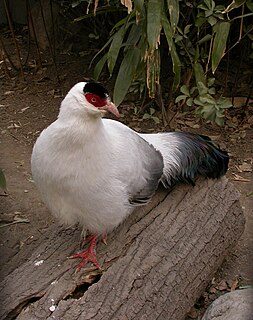
The white eared pheasant, also known as Dolan’s Eared Pheasant or Bee's pheasant, is a species of "eared pheasant" that get its name because its colouration is white and has the prominent ear tufts of the genus, not because it has white ears. The indigenous people of Himalaya call it shagga, meaning snow fowl. This gregarious bird lives in large flocks, foraging on alpine meadows close to or above the snowline throughout the year. C. crossoptilon is found in China, Qinghai, Sichuan, Yunnan, and Tibet, where it tends to inhabit mixed forests and can be found around Buddhist monasteries.

The mountain goat, also known as the Rocky Mountain goat, is a hoofed mammal endemic to North America. A subalpine to alpine species, it is a sure-footed climber commonly seen on cliffs and ice.
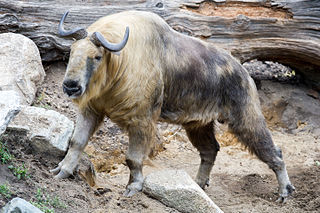
The takin, also called cattle chamois or gnu goat, is a large species of ungulate of the subfamily Caprinae found in the eastern Himalayas. It includes four subspecies: the Mishmi takin, the golden takin, the Tibetan takin, and the Bhutan takin.
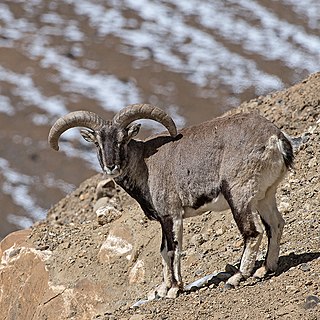
The bharal, also called the blue sheep, is a caprine native to the high Himalayas; it occurs in India, Bhutan, China, Myanmar, Nepal, and Pakistan. The Helan Mountains of Ningxia have the highest concentration of bharal in the world, with 15 bharals per km2 and 30,000 in total.

The Tibetan fox, also known as Tibetan sand fox, is a species of true fox endemic to the high Tibetan Plateau, Ladakh plateau, Nepal, China, Sikkim, and Bhutan, up to elevations of about 5,300 m (17,400 ft). It is listed as Least Concern in the IUCN Red List, on account of its widespread range in the Tibetan Plateau's steppes and semi-deserts.

The argali, also known as the mountain sheep, is a wild sheep that roams the highlands of western East Asia, the Himalayas, Tibet, and the Altai Mountains.
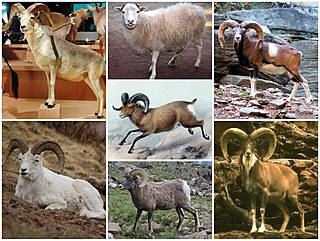
Ovis is a genus of mammals, part of the Caprinae subfamily of the ruminant family Bovidae. Its seven highly sociable species are known as sheep. Domestic sheep are members of the genus, and are thought to be descended from the wild mouflon of central and southwest Asia.
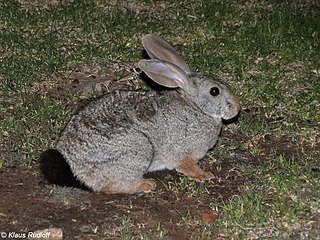
Jameson's red rock hare is a leporid found only on the continent of Africa, mostly in the southern portion of the continent. Zimbabwe and Namibia are thought to have the largest populations of the red rock hare and it is said to be found throughout both countries. South Africa has a population of this red rock hare but it is only found in the northwestern part of the country. Botswana also has a population in the Tswapong Hills.

Thorold's deer is a threatened species of deer found in grassland, shrubland, and forest at high altitudes in the eastern Tibetan Plateau. It is also known as the white-lipped deer for the white patches around its muzzle.

Hemis National Park is a high altitude national park in Ladakh, India. Globally famous for its snow leopards, it is believed to have the highest density of them in any protected area in the world. It is the only national park in India that is north of the Himalayas, the largest notified protected area in India and is the second largest contiguous protected area, after the Nanda Devi Biosphere Reserve and surrounding protected areas. The park is home to a number of species of endangered mammals, including the snow leopard. Hemis National Park is India's protected area inside the Palearctic realm, outside the Changthang Wildlife Sanctuary northeast of Hemis, and the proposed Tso Lhamo Cold Desert Conservation Area in North Sikkim.

The red goral is a species of even-toed ungulate in the subfamily Caprinae in the family Bovidae. It is found in India, Tibet and Myanmar. Its natural habitats are seasonal mountainous areas 1,000 to 2,000 meters above sea level. It is threatened by habitat loss and hunting.

The grey-bellied comet is a species of hummingbird in the family Trochilidae. It is found only in a few small areas of Peru. Its natural habitats are subtropical or tropical high-altitude shrubland and rural gardens. It is threatened by habitat loss.
The Sichuan partridge is a bird species in the family Phasianidae. It is found only in China where it is classified as a nationally protected animal. Its natural habitat is temperate forest. It is threatened by habitat loss.
The Marquesan kingfisher or Marquesas kingfisher is a species of bird in the family Alcedinidae. It is endemic to French Polynesia. It is threatened by habitat loss and predation by introduced species, and is currently classified as Critically endangered, with fewer than 500 individuals left in the wild.
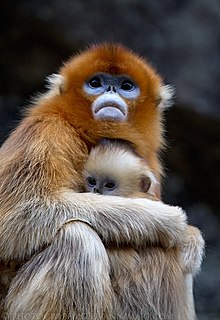
The golden snub-nosed monkey is an Old World monkey in the subfamily Colobinae. It is endemic to a small area in temperate, mountainous forests of central and Southwest China. They inhabit these mountainous forests of Southwestern China at elevations of 1,500–3,400 m (4,900–11,200 ft) above sea level. The Chinese name is Sichuan golden hair monkey (四川金丝猴). It is also widely referred to as the Sichuan snub-nosed monkey. Of the three species of snub-nosed monkeys in China, the golden snub-nosed monkey is the most widely distributed throughout China.
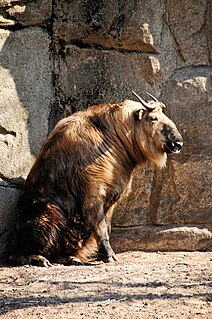
The Sichuan takin or Tibetan takin is a subspecies of takin (goat-antelope). Budorcas from Greek bous and dorkas ("gazelle"); taxicolor from Latin taxus ("badger") and color ("hue") referring to badger-like coloration Listed as a vulnerable species, the Sichuan takin is native to Tibet and the provinces of Sichuan, Gansu and Xinjiang in the People's Republic of China.
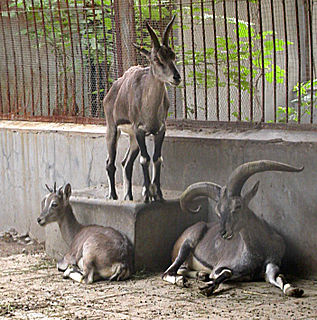
Pseudois is a genus in the subfamily Caprinae comprising two species, the bharal and the dwarf blue sheep. Both species in the genus are variously known as blue sheep, the bharal's alternate name being the Himalayan blue sheep.



















